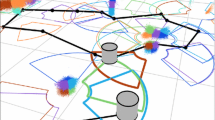Abstract
We present a purely vision-based scheme for learning a topological representation of an open environment. The system represents selected places by local views of the surrounding scene, and finds traversable paths between them. The set of recorded views and their connections are combined into a graph model of the environment. To navigate between views connected in the graph, we employ a homing strategy inspired by findings of insect ethology. In robot experiments, we demonstrate that complex visual exploration and navigation tasks can thus be performed without using metric information.
Similar content being viewed by others
References
Bachelder, I.A. and Waxman, A.M. 1995. A view-based neurocomputational system for relational map-making and navigation in visual environments. Robotics and Autonomous Systems, 16:267- 289.
Brooks, R.A. 1986. A robust layered control system for a mobile robot. IEEE Journal of Robotics and Automation, RA-2(1).
Cartwright, B.A. and Collett, T.S. 1983. Landmark learning in bees. J. Comp. Physiol. A, 151:521-543.
Chahl, J.S. and Srinivasan, M.V. 1996. Visual computation of egomotion using an image interpolation technique. Biol. Cybern., 74:405-411.
Collett, T.S. 1992. Landmark learning and guidance in insects. Phil. Trans. R. Soc. Lond. B, 337:295-303.
Collett, T.S. 1996. Insect navigation en route to the goal: Multiple strategies for the use of landmarks. J. Exp. Biol., 199:227-235.
Franz, M.O., Schölkopf, B., and Bülthoff, H.H. 1997. Homing by parameterized scene matching. In Fourth Europ. Conf. on Artificial Life, P. Husbands and I. Harvey (Eds.), MIT Press: Cambridge, MA, pp. 236-245.
Franz, M.O., Schölkopf, B., Georg, P., Mallot, H.A., and Bülthoff, H.H. 1997. Learning view graphs for robot navigation. In Proc. 1. Intl. Conf. on Autonomous Agents, W.L. Johnson (Ed.), ACM Press: New York, pp. 138-147.
Gallistel, R. 1990. The Organization of Learning, MIT Press: Cambridge, MA.
Gillner, S. and Mallot, H.A. 1997. Navigation and acquisition of spatial knowledge in a virtual maze. J. Cognitive Neuroscience. In press.
Goldman, S. 1953. Information Theory, Dover: New York.
Hong, J., Tan, X., Pinette, B., Weiss, R., and Riseman, E.M. 1991. Image-based homing. In Proc. IEEE Intl. Conf. on Robotics and Automation, pp. 620-625.
Kuipers, B.J. and Byun, Y. 1991. A robot exploration and mapping strategy based on a semantic hierarchy of spatial representations. Robotics and Autonomous Systems, 8:47-63.
Lieblich, I. and Arbib, M.A. 1982. Multiple representations of space underlying behavior. Behavioral and Brain Sciences, 5:627-659.
Mallot, H., Bülthoff, H., Georg, P., Schölkopf, B., and Yasuhara, K. 1995. View-based cognitive map learning by an autonomous robot. In Proc. ICANN'95-Int. Conf. on Artificial Neural Networks, F. Fogelman-Soulié and P. Gallinari (Eds.) EC2, Nanterre, France, Vol. II, pp. 381-386.
Mataric, M.J. 1991. Navigating with a rat brain: Aneurobiologically-inspired model for robot spatial representation. In From Animals to Animats, J.-A. Meyer and S.W. Wilson (Eds.), MIT Press: Cambridge, MA.
O'Keefe, J. and Nadel, L. 1978. The Hippocampus as a Cognitive Map, Clarendon Press: Oxford.
O'Neill, M.J. 1991. Evaluation of a conceptual model of architectural legibility. Environment and Behavior, 23:259-284.
Piaget, J. and Inhelder, B. 1967. The Child's Conception of Space, Norton: New York.
Poucet, B. 1993. Spatial cognitive maps in animals: New hypotheses on their structure and neural mechanisms. Psychological Rev., 100:163-182.
Röfer, T. 1995. Controlling a robot with image-based homing. Center for Cognitive Sciences, Bremen, Report 3/95.
Schölkopf, B. and Mallot, H.A. 1995. View-based cognitive mapping and path planning. Adaptive Behavior, 3:311-348.
Thrun, S. 1995. Exploration in active learning. In The Handbook of Brain Theory and Neural Networks, M.A. Arbib (Ed.), MIT Press, pp. 381-384.
Tolman, E.C. 1932. Purposive Behavior of Animals and Men, Irvington: New York.
Wehner, R., Michel, B., and Antonsen, P. 1996. Visual navigation in insects: Coupling of egocentric and geocentric information. J. Exp. Biol., 199:129-140.
Yagi, Y., Nishizawa, Y., and Yachida, M. 1995. Map-based navigation for a mobile robot with omnidirectional image sensor COPIS. IEEE Trans. Robotics Automat., 11:634-648.
Author information
Authors and Affiliations
Rights and permissions
About this article
Cite this article
Franz, M.O., Schölkopf, B., Mallot, H.A. et al. Learning View Graphs for Robot Navigation. Autonomous Robots 5, 111–125 (1998). https://doi.org/10.1023/A:1008821210922
Issue Date:
DOI: https://doi.org/10.1023/A:1008821210922




